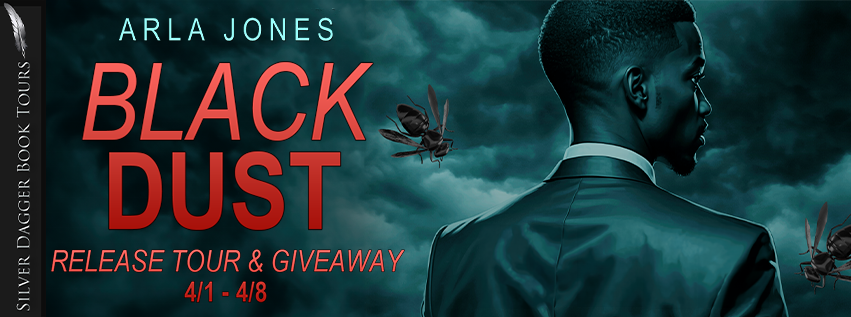Get ready for a pulse-pounding journey through the
darkest corridors of power in the Otis Thorne thriller
series!
In the second Otis Thorne thriller, a malevolent alliance
triggers a global pandemic, forcing Thorne and Noah
into a race against time. Can they unravel the sinister
plot?
Black Dust
The Otis Thorne Thriller Series Book 2
by Arla Jones
Genre: Thriller, Suspense
An action-packed thriller for fans of Clancy, Thor, and
Flynn, Great for readers of political conspiracies and
CIA counterterrorism missions.
This second book will leave you breathless and wanting more.
1 The Biting Dust
An underground research facility, North Korea, 2027
The underground facility was perfect for secret tests, including nuclear and chemical experiments that they did not want any of their enemies or neighboring countries to see on the satellite. The facility was dug deep underground into a volcanic mountain that hadn’t experienced any volcanic activity for years. Only the high-ranking members of the Worker’s Party knew about this facility.
The secret nuclear weapon and chemical weapon research in this facility created an environmental change in the bugs that had come in contact with the research area. The tiny insects that survived the chemical environmental change moved in the air like a cloud of black dust, looking for a living animal or person, and then attaching to the skin. The scientists called these bugs:
무는 먼지 muneun meonji which meant the biting dust.
It was a new form of life, not exactly anything that had existed before, but they were tough and resilient, like cockroaches, and could survive almost anything. The only difference was that these bugs were microscopic and moved together, never individually.
The scientists were both surprised and horrified by what they had created. They knew that, for example, grasshoppers could change their behavior because of crowding, which is called density-dependent phenotypic plasticity and refers to the bugs changing behavior due to environmental factors. The North Korean scientists suspected that something similar had happened to these bugs that had survived the chemical and nuclear research area, and thus, this new form of black bugs appeared on Earth.
When the sun set and it became dark, these bugs searched for their next target, any warm-blooded living thing would do, and they started biting. For some reason, the bugs never moved or bit during the daytime.
The scientists first thought was that the reports of the biting bugs were just imagination or hallucination, but when they got a sample of the black dust under the microscope, the bug looked more like a blackish-green crystal than a normal bug except this crystallized bug was alive. It was a new form of life created by chemical weapons.
The researchers observed that these insects exhibited movement to locate their target specifically during cooler temperatures, typically after sunset. They hypothesized that each minuscule bug functioned like a vampire, extracting blood from the host, resulting in a sensation of biting and itching. This experience often gave the impression of something crawling on the skin, followed by a subsequent sting, with the intensity increasing based on the number of bugs present on the skin. The scientists studied the bugs some more and realized that and realized they could reproduce themselves.
The bugs displayed no distinction between males and females. The researchers observed that the life cycle of adult-sized insects spanned approximately five days, following a developmental period of one week to reach this stage.
At the end of the adult-sized bugs' life cycle, the insect emitted a cloud of black dust, smaller than its original size and measuring approximately one-fifth of a millimeter. These entities, referred to by scientists as eggs, cracked open resembling a butterfly's cocoon, revealing larvae inside. These juvenile bugs exhibited rapid growth, reaching the size of an adult, around half a millimeter, within a week. The most troubling discovery was that the scientists could not find any method to kill these bugs or their eggs. They tried all kinds of pesticides to no avail. They even tried to burn a building infested with these bugs, but the bugs survived.
They conceded that there was no established method for exterminating these nightcrawlers. However, the scientists soon recognized that they possessed an unparalleled weapon, unique in the world. It was now imperative to devise a strategy for employing these insects to their advantage against their adversaries.
***
The next phase was to experiment with the labor camp prisoners. They chose a distant location in Hoeryong, where the notorious concentration camp was reportedly closed in 2012. However, in reality, it was still running state-supported secret experiments on the remaining political prisoners.
This infamous camp was in North Hamgyong province in northeast North Korea, close to China’s border and about 700 miles away from the Sea of Japan. Regardless of how close the camp was to the Chinese border, not many prisoners escaped.
It was heavily guarded, and the experiments and malnutrition made the prisoners weak and sick. Most of them were brought there in the back of a truck in the middle of the night, so they never saw the outside of the camp and where it was located. They had poor-quality shoes that were not made to walk long distances along the valleys and hills on uneven ground. If they escaped, their prison outfit would not keep them warm during the freezing nights when the temperature dropped below twenty Fahrenheit.
It was the perfect place for the new secret weapon experiment.
The prisoners were never told what the new experiment would be. They were just exposed to it. This time it was the bugs!
Giveaway
Swag Pack, $10 Amazon giftcard – 1 winner each!
Follow the tour HERE for special content and a giveaway!




No comments:
Post a Comment